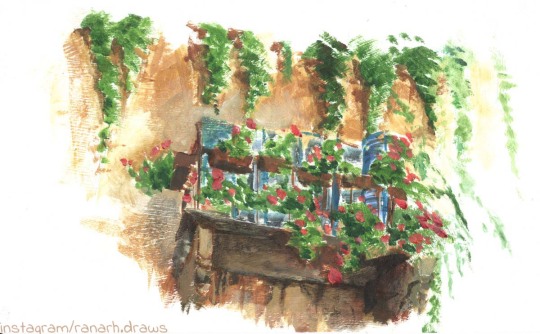#verticalgardening
Explore tagged Tumblr posts
Text
#HangingBaskets#VerticalGardening#DecorativePlants#HangingGreenery#BalconyDecor#WallPlants#StylishGardens#GardenDecor#PottedPlants#HangingPlants
0 notes
Text
#GreenWalls#VerticalGardening#Sustainability#UrbanGreening#EnvironmentalBenefits#AestheticAppeal#HealthAndWellbeing
0 notes
Text

Flowers on an italian balcony (again), working with fading the motif into the white background, acrylic on paper, 25×15cm. Painted from reference photo in about an hour and a half. I typically do these form leftover paints because it's fun to see what can be done with simple subjects; although honestly the overlapping plantlife in this piece wasn't all that easy. I wish all houses were so nicely overgrown with vegetation. Does wonders for cooling, too.
#acrylicsketch#flowers#italy#balcony#garden#summer#blacony#flowerpots#window#noon#traditionalart#painting#botany#verticalgardening#cityofthefuture#heatplan
1 note
·
View note
Text
The Ultimate Vertical Gardening Checklist: 7 Must-Know Tips
Check out our latest blog about Vertical Gardening

0 notes
Text

Learn more: https://hydroponicway.com/how-to-grow-plants-with-the-kratky-hydroponics
The Kratky hydroponic growing technique is simple, effective and easy to use.
However, it can be improved upon with these tips.
#sustainability#gardening#farming#hydroponicfarming#hydroponics#hydroponicsystem#gardeningtips#verticalfarming#aeroponics#aquaponics#agriculture#agriculturetechnology#agritechnology#garden#indoorfarming#sustainable#gardening101#agritech#urbanfarming#verticalgarden#indoorgarden#future#diy#food#healthyfood#hydroponic#hydroponicgarden#growlight
10 notes
·
View notes
Text
Transform Your Outdoor Space with Melbourne Landscapers
GardenMore Landscaping offers the best Melbourne landscapers. We create stunning outdoor spaces that enhance the beauty and functionality of your property. Our landscaping experts in Melbourne focus on quality, creativity, and customer satisfaction. Let us show you the difference. We can help you create the landscape of your dreams. Contact us today for a consultation.

2 notes
·
View notes
Text
#HangingBaskets#VerticalGardening#DecorativePlants#HangingGreenery#BalconyDecor#WallPlants#StylishGardens#GardenDecor#PottedPlants#HangingPlants
0 notes
Text

🌱 Dreaming of fresh, homegrown salad greens? 🥗 The Garden Tower Project 2 is your answer! 🍅🥬 Learn how to grow a lush salad tower right at home and maximize your gardening potential, even in small spaces! 🌞🌿
📚 Read the full guide and get started: https://containergardeningebook.com/how-to-grow-a-salad-tower
#SaladTower#saladTower#VerticalGardening#GardenTower#OrganicGardening#HomeGarden#GreenLiving#DIYGarden#UrbanGardening#GrowYourOwn
0 notes
Video
youtube
Büyüleyici Dikey Bahçeler ve Harika Bahçe Duvarı Süslemeleri ile Alanını...
#youtube#dikeybahçe dikeybahçenasılyapılır yapaydikeybahçeyapımı verticalgarden howtomakeaverticalgarden artificialverticalgardenmaking
2 notes
·
View notes
Text
#VerticalGarden#WallPlants#SmallSpaceGardening#DecorativeGreenery#AirPurifying#UrbanGardening#VibrantPlants#TropicalPlants#LowMaintenance#VerticalDecor
0 notes
Text
Мегаполис нового поколения на закате: здания, сливающиеся с зелеными вертикальными оазисами, элементы стиля киберпанк, виртуальные билборды, неоновые огни, летающие беспилотники. Здесь природная красота сочетается с передовой техникой, формируя атмосферу из кинематографа будущего с безграничной четкостью и искусством, вдохновленным кибернетикой…
0 notes
Text
Wall Planters

Transform your walls into a lush vertical garden with adorable mini wall planters! 🌱 Perfect for small spaces, these planters add a splash of greenery and a modern touch to your home or office decor. Ideal for succulents, herbs, or trailing plants. 🌿✨
#MiniWallPlanters#GreenDecor#VerticalGarden#PlantLovers#HomeStyling#IndoorPlants#ModernDecor#PlantParent#WallArt
0 notes
Photo

Godrej Parkridge #Pune MAHAREARA NO : P52100028310 Welcome to an address where close to 80% open space invites you to breathe freely. Here, over 1 hectare of vehicle-free greens surrounds your home. Nestled amidst a 40-hectare township, here a 1 Km nature trail, a fruit orchard, a herbal garden and a rejuvenating swimming pool come together to create a naturally healthy lifestyle. It will be the perfect place to grow and explore your potential as you celebrate the joy of living. 1, 2 & 3 BHK homes starting from ₹39.48 Lakh onwards Key Features: ▪️Builder of the year - at the CNBC awaaz in 2019 brand trust report ▪️80% Open Spaces and 500+ Oxygen enhancing Trees ▪️A massive club house sprawled across 6500+ sqmt ▪️Over 1 hectare of vehicle-free greens surround your home ▪️Get connect to 13 acres of green necklace ▪️Green open air theater ▪️Vertical garden within the vicinity Project Amenities: ▪️Badminton Court ▪️Tennis Court ▪️Steam & Sauna ▪️Yoga Deck ▪️Basketball Court ▪️Banquet hall ▪️Indoor Games ▪️18-hole golf course ▪️15-seater Miniplex ▪️Cards Room #GodrejParkridge #Pune #OpenSpaces #HealthyLiving #NatureTrail #FruitOrchard #HerbalGarden #SwimmingPool #1BHKHomes #2BHKHomes #3BHKHomes #AffordableLuxury #BuilderOfTheYear #OxygenEnhancingTrees #ClubHouse #VehicleFreeLiving #GreenNecklace #OpenAirTheater #VerticalGarden #BadmintonCourt #TennisCourt #YogaDeck #BasketballCourt #GolfCourse #Miniplex #IndoorGames #LuxuryAmenities 🌳🏡🌞
#Pune#GodrejParkridge#OpenSpaces#HealthyLiving#NatureTrail#FruitOrchard#HerbalGarden#SwimmingPool#1BHKHomes#2BHKHomes#3BHKHomes#AffordableLuxury#BuilderOfTheYear#OxygenEnhancingTrees#ClubHouse#VehicleFreeLiving#GreenNecklace#OpenAirTheater#VerticalGarden#BadmintonCourt#TennisCourt#YogaDeck#BasketballCourt#GolfCourse#Miniplex#IndoorGames#LuxuryAmenities
0 notes